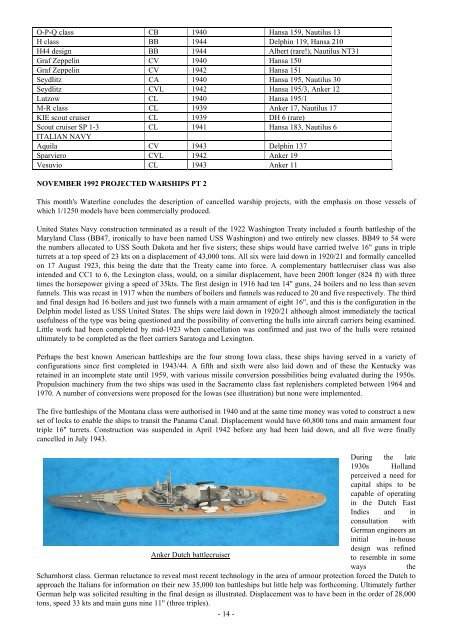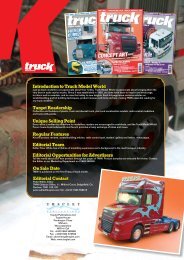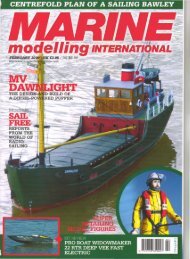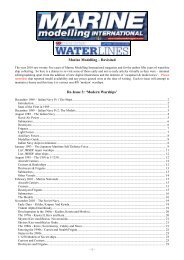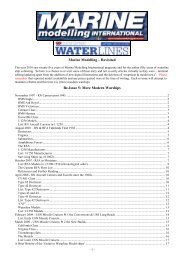Marine Modelling â Revisited Re-Issue 2: 'Foreign Warships'
Marine Modelling â Revisited Re-Issue 2: 'Foreign Warships'
Marine Modelling â Revisited Re-Issue 2: 'Foreign Warships'
You also want an ePaper? Increase the reach of your titles
YUMPU automatically turns print PDFs into web optimized ePapers that Google loves.
O-P-Q class CB 1940 Hansa 159, Nautilus 13<br />
H class BB 1944 Delphin 119, Hansa 210<br />
H44 design BB 1944 Albert (rare!), Nautilus NT31<br />
Graf Zeppelin CV 1940 Hansa 150<br />
Graf Zeppelin CV 1942 Hansa 151<br />
Seydlitz CA 1940 Hansa 195, Nautilus 30<br />
Seydlitz CVL 1942 Hansa 195/3, Anker 12<br />
Lutzow CL 1940 Hansa 195/1<br />
M-R class CL 1939 Anker 17, Nautilus 17<br />
KIE scout cruiser CL 1939 DH 6 (rare)<br />
Scout cruiser SP 1-3 CL 1941 Hansa 183, Nautilus 6<br />
ITALIAN NAVY<br />
Aquila CV 1943 Delphin 137<br />
Sparviero CVL 1942 Anker 19<br />
Vesuvio CL 1943 Anker 11<br />
NOVEMBER 1992 PROJECTED WARSHIPS PT 2<br />
This month's Waterline concludes the description of cancelled warship projects, with the emphasis on those vessels of<br />
which 1/1250 models have been commercially produced.<br />
United States Navy construction terminated as a result of the 1922 Washington Treaty included a fourth battleship of the<br />
Maryland Class (BB47, ironically to have been named USS Washington) and two entirely new classes. BB49 to 54 were<br />
the numbers allocated to USS South Dakota and her five sisters; these ships would have carried twelve 16" guns in triple<br />
turrets at a top speed of 23 kts on a displacement of 43,000 tons. All six were laid down in 1920/21 and formally cancelled<br />
on 17 August 1923, this being the date that the Treaty came into force. A complementary battlecruiser class was also<br />
intended and CC1 to 6, the Lexington class, would, on a similar displacement, have been 200ft longer (824 ft) with three<br />
times the horsepower giving a speed of 35kts. The first design in 1916 had ten 14" guns, 24 boilers and no less than seven<br />
funnels. This was recast in 1917 when the numbers of boilers and funnels was reduced to 20 and five respectively. The third<br />
and final design had 16 boilers and just two funnels with a main armament of eight 16", and this is the configuration in the<br />
Delphin model listed as USS United States. The ships were laid down in 1920/21 although almost immediately the tactical<br />
usefulness of the type was being questioned and the possibility of converting the hulls into aircraft carriers being examined.<br />
Little work had been completed by mid-1923 when cancellation was confirmed and just two of the hulls were retained<br />
ultimately to be completed as the fleet carriers Saratoga and Lexington.<br />
Perhaps the best known American battleships are the four strong Iowa class, these ships having served in a variety of<br />
configurations since first completed in 1943/44. A fifth and sixth were also laid down and of these the Kentucky was<br />
retained in an incomplete state until 1959, with various missile conversion possibilities being evaluated during the 1950s.<br />
Propulsion machinery from the two ships was used in the Sacramento class fast replenishers completed between 1964 and<br />
1970. A number of conversions were proposed for the Iowas (see illustration) but none were implemented.<br />
The five battleships of the Montana class were authorised in 1940 and at the same time money was voted to construct a new<br />
set of locks to enable the ships to transit the Panama Canal. Displacement would have 60,800 tons and main armament four<br />
triple 16" turrets. Construction was suspended in April 1942 before any had been laid down, and all five were finally<br />
cancelled in July 1943.<br />
During the late<br />
1930s Holland<br />
perceived a need for<br />
capital ships to be<br />
capable of operating<br />
in the Dutch East<br />
Indies and in<br />
consultation with<br />
German engineers an<br />
initial in-house<br />
design was refined<br />
Anker Dutch battlecruiser<br />
to resemble in some<br />
ways<br />
the<br />
Scharnhorst class. German reluctance to reveal most recent technology in the area of armour protection forced the Dutch to<br />
approach the Italians for information on their new 35,000 ton battleships but little help was forthcoming. Ultimately further<br />
German help was solicited resulting in the final design as illustrated. Displacement was to have been in the order of 28,000<br />
tons, speed 33 kts and main guns nine 11" (three triples).<br />
- 14 -


